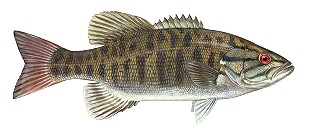 |
Springtime bass angling is the perfect way to turn new anglers or your kids on to fishing. You will all enjoy their terrific fighting tendencies and the sheer number of bass that are available in the spring adds up to great fun. I believe our Northwoods bass fishery is one of our best kept secrets. Growth rates here are average to above average. In many regards our smallmouth fishery is virtually untapped. Everybody knows the Northwoods for walleye and musky fishing but our bass have exploded in many lakes. Many feel that our bass fishing rivals Chequamegon Bay or Green Bay for quality smallmouth. In the Northern Zone bass season opens on May 5th. To protect the large spawners from being harvested it is strictly catch and release until June 15th. The spawning process is reliant on water temperature but usually happens around the second week of May until the first week of June. Pre-spawn find the fish staging in the deeper water. Then the sun heats up the shallows and this solar window makes them move in. They’ll pick out their beds and fan them out with their tails. Then they get into the nest to spawn together. Afterwards the females leave but the smaller males stay around to guard the nest. The whole cycle usually lasts 3-4 weeks. Spring patterns are rather predictable with crankbaits by far the most productive lure prior to the hard spawn. The fish are cruising around in 8′-10′ of water outside their spawning areas. They are in schools and are very competitive. They’re lots of fun to catch on a rattle type bait or deep diving crankbait. Use a straight, slow retrieve to get the bait down really deep. I also highly recommend using a snap. Snaps give crankbaits extra wobble for increased action. Crawdad imitators or natural colors are very effective. Once the fish start moving into the shallows they can be caught on stickbaits, but this is the time you should switch to plastics. 3″ tubes are my favorite weapon. I suggest working an area thoroughly with a stick type crankbait or a spinnerbait to locate the most aggressive fish. Then come back through and finesse the rest with a tube bait. Tubes in black, chartreuse, and crayfish colors work well on our area waters. Employ a slow, swimming retrieve with a pumping and lifting technique. Do not drag the tubes on the bottom of the lake because they easily snag. When the fish begin spawning on their beds catching them becomes much tougher. They are more selective during this time. Switch to a 3″reaper (plastic lure) on a 1/16 oz jighead. A subtle, ultra finesse presentation is required in the shallow, clear water. As the spawn tapers off the water temperatures continue to climb and just about anything you have in your tackle box will produce. The females are recovering in the deep but the males are feeding aggressively. Post-season spawn will find bass on the inside edges of weeds and in timber and brush. The top bass magnet during post spawn periods are piers and docks. Pre-spawn to spawn oftentimes finds largemouths in the reeds. Since the reeds are newly emerging it is easier to get through them without getting hung up. Toss in a spinnerbait and bulge it on the top of the water. This makes for exciting action. Small, shallow lakes predominately hold largemouth while smallmouth favor deep, clear lakes. There are some lakes in our area where they co-exist. Preferred forage for both species are crayfish. I’d guess the average size bass that I see being caught as 1 ½ #, 14″ with lunkers in the 5#, 20″ range and even an occasional six to eight pounder. Here are a few more pointers to help catch these big fish: Buy a pair of good polarized sunglasses. These are imperative to locate them when they are bedded up. Be mobile on your lake choice. Deeper lakes will be later off in the spawn cycle so game plan your fishing season to hit the shallow lakes first then switch to deeper ones to extend your fun. Set up different rods with a variety of lures. Have your partner throw a white and silver spinnerbait, for example, while you toss a black tube. This is a great way to find out what they are hitting on that particular day. Smallmouths love the color chartreuse! Keep tabs on your favorite bass lake. When the big females move in to spawn they are only there for a 3-6 day period before they move back out into the deep. Remember: Optimum spring weather for fishing is warm, sunny, and calm-just the opposite of the perfect summertime conditions. For the health of the fish, stick with artificial baits during springtime, especially during the catch and release period. Bass are feeding so aggressively then that they can swallow live bait and the hook and hinder the release rate. You don’t need to get really fancy with rigs in the springtime. Just grab your son or daughter, throw in a couple of 6 to 6’6″ rods with spinning or baitcasting setups (filled with 6-10# mono) and a variety of crankbaits, spinnerbaits, and plastic lures. Head out on one of our local Northwoods lakes and I guarantee you will have the time of your lives. Bass fishing in the spring is hard to beat. Patricia Strutz, “A Blond and Her Boat”, is a musky fishing zealot whose energy and enthusiasm for the sport is contagious. Her true passion is row trolling for ‘skies in late fall. She offers traditional casting packages, too. Strutz also works with other pro’s to offer group fishing trips to Wisconsin, Minnesota, and Canada. Check out the WOW! Women on the Water page for complete details. Patricia especially enjoys teaching other women how to hunt muskies. She is an outdoor writer, instructional DVD host, and may be booked to give presentations on musky fishing to interested groups. www.ablondandherboat.com |